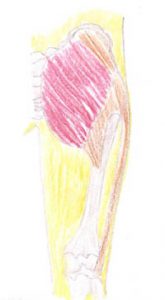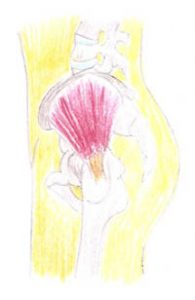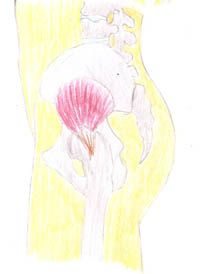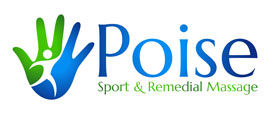In daily life we rarely refer to the ‘the gluteals’. Instead, we use terms like our buttocks or bottom or posterior. The glueals actually refer to a group of 3 muscles: gluteus maximus, gluteus medius and gluteus minimus. As a result, they can often be abbreviated to ‘the gluts’.
The gluteus maximus is the biggest of the 3 muscles. It is the one we most think of as the bottom. It is located on the posterior (the back) of the hip. The medius and minimus muscles are actually on the lateral side of your hip. Because the gluteals muscles have to move in different directirons, they all have multi-directional fibers.
Where are they?

Gluteus maximus: Origin is the coccyx; the edge of the sacrum (last 5 fused vertebrae); posterior iliac crest, sacrotuberous and sacroilliac ligaments. The insertion is the iliotibial tract (for the upper fibers) and gluteal tuberosity (for the lower fibers).

Gluteus Medius: The origin is the gluteal surface of the ilium just below the iliac crest. The insertion is the lateral aspect of the great trochanter.

Gluteus Minimus: The origin is the gluteal surface of the illium. The insertion is the anterior aspect of the greater trochanter.
What do the gluteals do?
Start walking, running or moving and you will feel the gluteal muscles in action. Those multi-directional fibres allow us to move in any direction.. Even standing results in the gluteal muscles contracting statically to stabilise the hip to maintain an upright position. Consequently, the only time these muscles ‘switch off’ is when we are sitting on them!
This is what each muscle does:
Gluteus maximus: All fibers extend, laterally rotate and abduct the hip. The lower fibers also adduct the hip.
Gluteus Medius: All fibers abduct the hip. The anterior fibers flex and medially rotate the hip. The posteriour fibers extend and laterally rotate the hip.
Gluteus Minimus: Abducts, medially rotates and flexes the hip.
Problems with the Gluteals
Your gluteal muscles have a significant role on the action of the Sacro-iliac or SI Joint. This joint joins your spine to your pelvis. The SI joint gives your hip flexibility bend forward and back. In effect the SI joint opens and closes and the gluteal muscles allow this to happen. As a result you are able to sit down and stand up. Because of this problems with the gluteals are closely linked to SI joint injuries and lower back pain.
Gluteal dysfunction can also have an impact on our gait – the way we walk. Because the muscles assist in hip extension and flexion, both of which we need in the action of walking.
The medius and minimus muscles work constantly in hip movements and have very little rest. As a result, they are more likely to be at risk of overuse injuries. Consequently, problems can often result in postural imbalances that can often be over-looked but affect the proper functioning of muscles.
Gluteal weakness and dysfunction can have a direct impact on the hamstrings. The two sets of muscles work together in hip extension. Therefore, they should ‘fire up’ in a specific sequence – gluteals, followed by hamstrings. But if the gluteals are experiencing dysfunction and have become weak, then the hamstrings will take over. As a result, the hamstrings become become tight – hypertonic – and become at risk of injury themselves.
Exercises for the Gluteals
To correct the ‘firing sequence’ of your gluteals and hamstrings try this exercise. This is a good exercise because it means that the gluteals have to work to lift your leg and the hamstrings can’t take part.
Lie on your stomach with one leg bent at the knee with the plantar side of your feet being parallel to the ceiling. Lift the bent leg towards the ceiling – it doesn’t have to be a big movement. Repeat 5 times on each leg, twice a day. By bending your leg you are removing the ability of the hamstrings to help with this movement and the gluteals have to do all the work.
Are you struggling to move because of back pain?
Do you feel like your back pain is always with you?
Could back pain be causing you to lose sleep?
If you answered ‘Yes’ to any of these questions then claim your free ‘Stop struggling with back pain. Massage Taster.
There are strictly limited spaces available. To claim your first free massage session click on the button below
“I had a stiff and aching lower back. I am already moving more freely and am delighted. The taster was great” (Corrine, Loughborough)
Here’s 3 reasons why you should claim your free massage taster today:
- Be give simple, clear steps to relieve your back pain
- The easy postural changes to start transforming the way you feel and move
- How releasing muscle tension is the key to unlocking back pain
Links:
Revised 29/5/19
